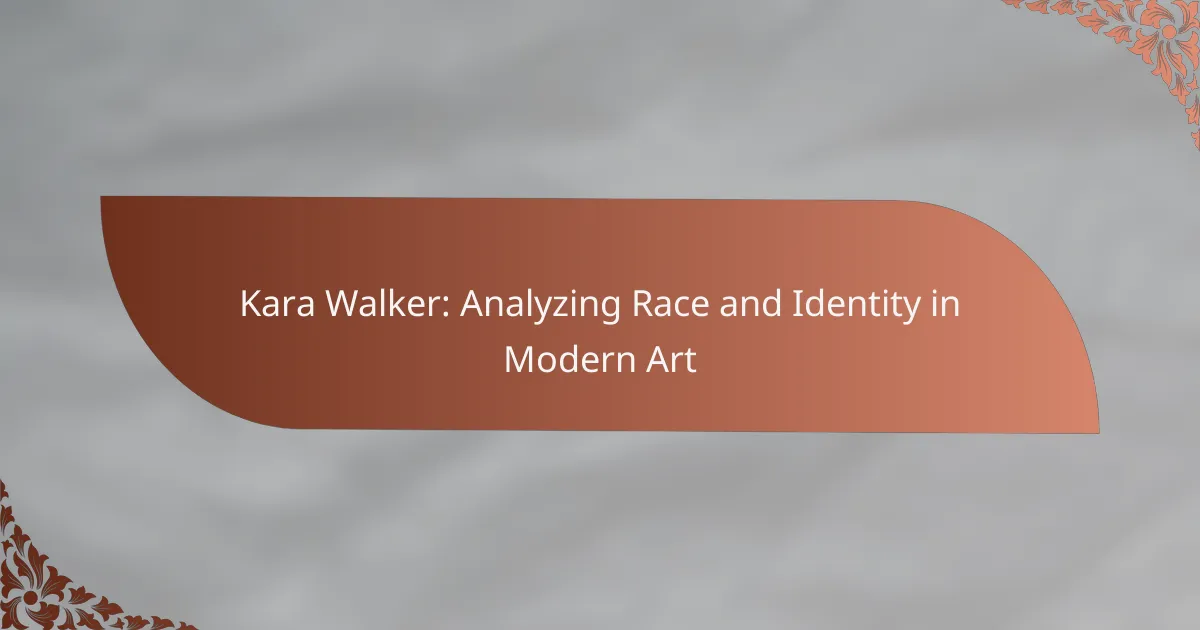Kara Walker’s art challenges viewers to confront uncomfortable truths about race and identity. This article examines her provocative imagery, unique storytelling techniques, and the emotional responses her work evokes. It explores her impact on contemporary art and the challenges she faces in representing complex themes. Additionally, we will discuss how educators can integrate her work into art curricula to foster critical thinking.
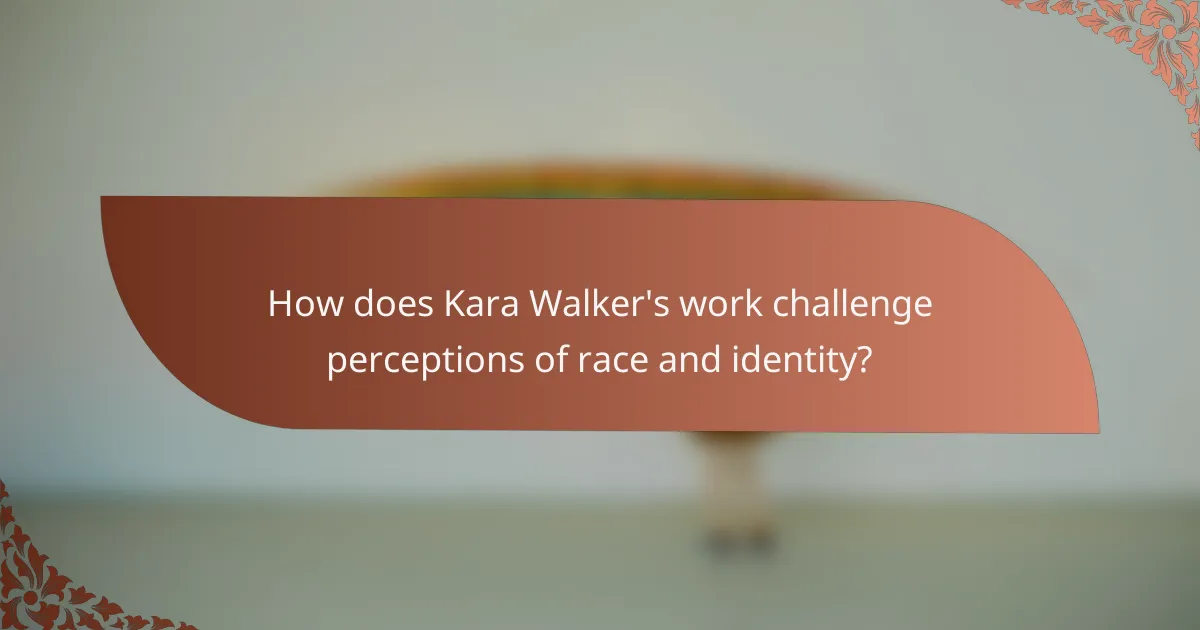
How does Kara Walker’s work challenge perceptions of race and identity?
Kara Walker’s work challenges perceptions of race and identity by using provocative imagery and historical references. Her art confronts viewers with uncomfortable truths about race relations and stereotypes, prompting critical reflection. Walker employs silhouettes and stark contrasts to illustrate the complexities of identity, often revealing the historical narratives that shape contemporary discussions. This unique approach invites dialogue and encourages audiences to reconsider their assumptions about race, power, and representation in society.
What themes are prevalent in Walker’s art?
Kara Walker’s art frequently explores themes of race, identity, and historical memory. These themes are represented through stark visuals and narratives that confront the complexities of African American experiences. Walker addresses the legacy of slavery and racism, often using silhouettes and provocative imagery to challenge viewers’ perceptions. Her work invites critical reflection on societal structures and personal identity, making these themes central to her artistic expression.
How does Walker use historical context to inform her narratives?
Kara Walker uses historical context to deepen her narratives about race and identity. She draws on the legacy of slavery and racial stereotypes, employing visual metaphors to challenge viewers’ perceptions. Walker’s work often references historical events and figures, creating a dialogue between the past and contemporary issues. For instance, her silhouettes evoke the antebellum South, prompting reflection on the enduring impact of racism. This context enriches her art, making it a powerful commentary on societal structures.
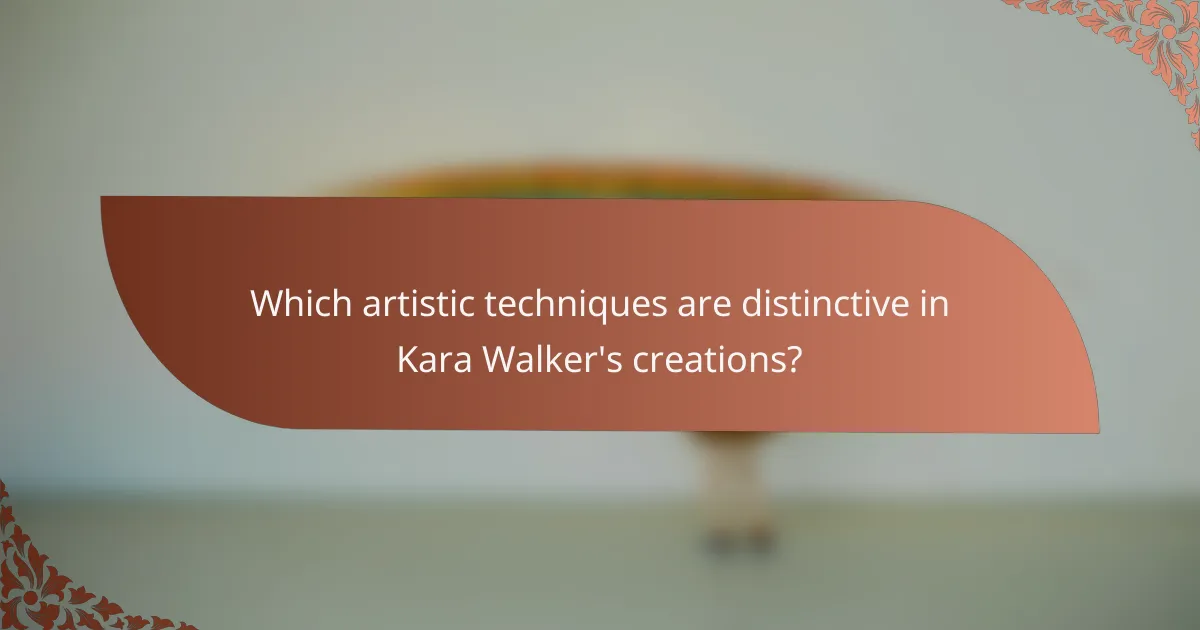
Which artistic techniques are distinctive in Kara Walker’s creations?
Kara Walker’s creations are distinctive for their use of silhouetted figures, narrative storytelling, and provocative themes. Her art explores race and identity through stark contrasts and historical references. The interplay of light and shadow in her installations emphasizes the emotional weight of her subjects. Additionally, her incorporation of materials like paper cutouts and projections creates a dynamic viewing experience.
How does silhouette art function in her storytelling?
Silhouette art in Kara Walker’s storytelling serves as a powerful visual language to explore themes of race and identity. Her use of stark black silhouettes against white backgrounds creates a striking contrast that emphasizes the narratives of African American history. This technique allows her to depict complex social issues, inviting viewers to engage with uncomfortable truths. Walker’s silhouettes often evoke historical figures and events, transforming them into a contemporary dialogue about race relations. By distilling her subjects into simple forms, she encourages reflection on the deeper implications of identity and power dynamics in society.
What role does color play in conveying her messages?
Color plays a crucial role in conveying Kara Walker’s messages about race and identity. It evokes emotional responses and highlights social themes. For instance, her use of stark contrasts emphasizes the complexities of racial narratives. The palette often reflects historical contexts, enhancing the viewer’s understanding of the artwork’s intent. Walker’s choice of colors also serves to challenge perceptions, prompting critical discussions around identity and power dynamics.
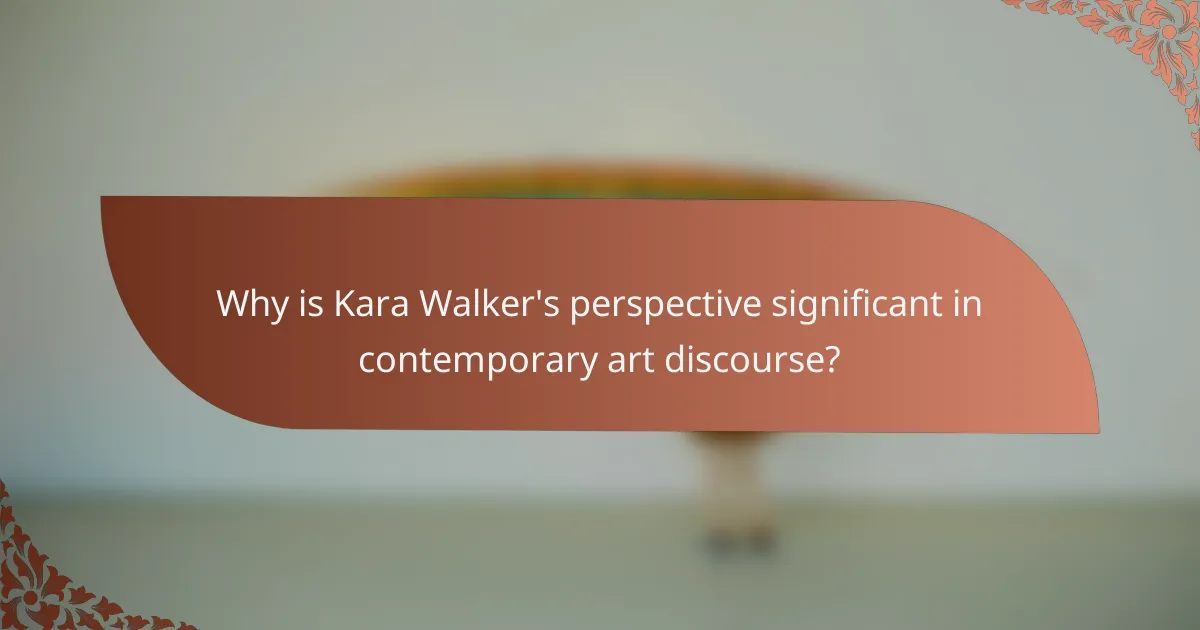
Why is Kara Walker’s perspective significant in contemporary art discourse?
Kara Walker’s perspective is significant because it challenges dominant narratives around race and identity in contemporary art. Her work confronts historical and societal injustices, prompting critical discourse. Walker employs powerful visual storytelling, often using stark imagery to evoke emotional responses. This unique approach allows her to dissect complex themes of race, gender, and sexuality, making her a pivotal figure in modern art discussions. Her ability to provoke thought and dialogue around these issues establishes her as an influential voice in shaping contemporary art’s trajectory.
How do critics interpret her contributions to discussions on race?
Critics interpret Kara Walker’s contributions to discussions on race as profound and provocative. Her artwork challenges racial stereotypes and engages viewers in dialogues about identity and history. Walker’s use of silhouette forms highlights the complexities of race and power dynamics. Critics often emphasize her unique ability to blend humor and horror, forcing audiences to confront uncomfortable truths about America’s past.
What impact has her work had on other artists and movements?
Kara Walker’s work has profoundly influenced contemporary artists and movements by challenging perceptions of race and identity. Her provocative narratives inspire discussions around historical trauma and cultural representation. As a result, many artists adopt similar themes, exploring identity politics and social justice in their work. Walker’s unique use of silhouette and narrative techniques has become a reference point for emerging artists addressing similar issues. This impact fosters a broader movement that interrogates the complexities of race in modern art.
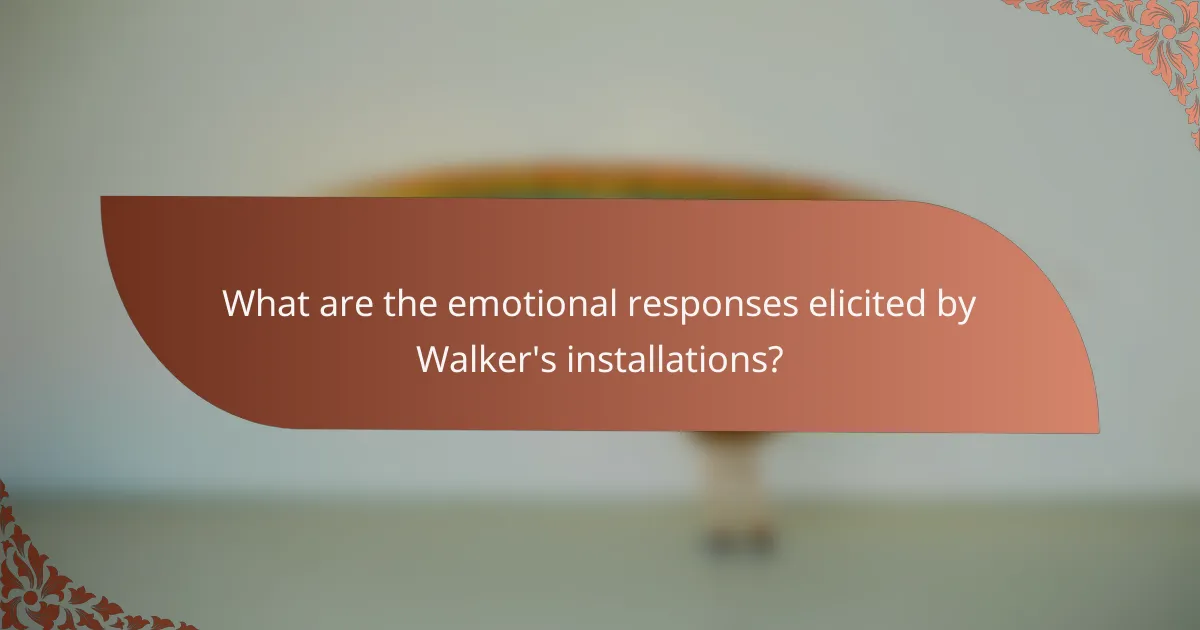
What are the emotional responses elicited by Walker’s installations?
Kara Walker’s installations elicit a range of emotional responses, including discomfort, anger, and introspection. These reactions stem from her provocative depictions of race and identity, challenging viewers to confront historical injustices. The stark imagery often invokes feelings of unease, prompting critical reflection on societal norms. Walker’s art serves as a mirror, revealing the complexities of identity and the emotional weight of racial narratives.
How do audiences engage with her provocative themes?
Audiences engage with Kara Walker’s provocative themes by reflecting on race, identity, and power dynamics. Her art prompts deep emotional responses, encouraging viewers to confront uncomfortable truths. Walker’s use of silhouette imagery invites personal interpretation, fostering dialogue around historical narratives. Additionally, her installations often challenge societal norms, prompting critical discussions about representation and memory.
What psychological effects are observed in viewers of her work?
Kara Walker’s work evokes complex psychological effects, including discomfort, reflection, and empathy. Viewers often confront their own biases and societal narratives surrounding race and identity. This engagement can lead to heightened awareness of historical injustices. The emotional responses vary, with some feeling anger or sadness, while others may experience catharsis or motivation for change. Walker’s unique use of silhouette forms amplifies these reactions, making the viewer’s experience deeply personal and introspective.
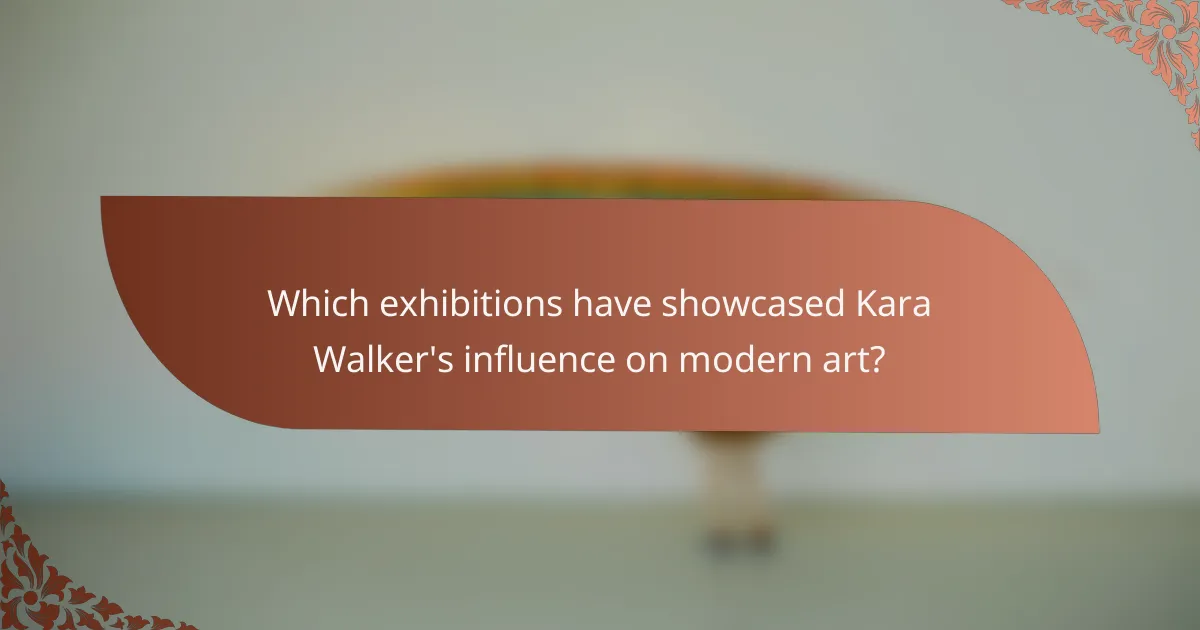
Which exhibitions have showcased Kara Walker’s influence on modern art?
Kara Walker’s influence on modern art has been showcased in exhibitions such as “Kara Walker: A Subtlety” at the Domino Sugar Factory in 2014 and “Kara Walker: The Black Figure in American Art” at the High Museum of Art in 2021. These exhibitions highlighted her exploration of race, identity, and historical narratives through provocative installations and silhouettes. Walker’s work challenges viewers to confront uncomfortable truths about race and representation in contemporary society.
What are the highlights of her most notable exhibitions?
Kara Walker’s notable exhibitions highlight her exploration of race and identity through provocative visuals. Key exhibitions include “Gone: An Historical Romance of a Civil War as It Occurred Between the Dusky Thighs of One Young Negress and Her Heart,” which showcases her signature silhouette style. “A Subtlety” at the Domino Sugar Factory presented a monumental installation that addressed themes of race and exploitation in American culture. Additionally, her work in the 2019 Venice Biennale emphasized the complexities of historical narratives surrounding race. Each exhibition reinforces her unique ability to blend history with contemporary issues, making her a pivotal figure in modern art.
How do different cultural contexts shape the reception of her work?
Cultural contexts significantly influence how Kara Walker’s work is received. Her art often critiques racial stereotypes and identity, resonating differently across various cultural backgrounds.
In predominantly African American communities, her exploration of race may evoke strong emotional responses, as it reflects shared histories and struggles. Conversely, audiences from different ethnic backgrounds might interpret her work through their unique cultural lenses, leading to varied understandings of her themes.
Walker’s use of silhouettes and historical references can provoke discussions on race relations, sparking dialogue in diverse cultural settings. These conversations might differ in intensity and focus, highlighting the unique attributes of each cultural context.
Ultimately, the reception of Walker’s work is shaped by the viewer’s cultural identity, personal experiences, and societal influences, making it a rich subject for analysis.
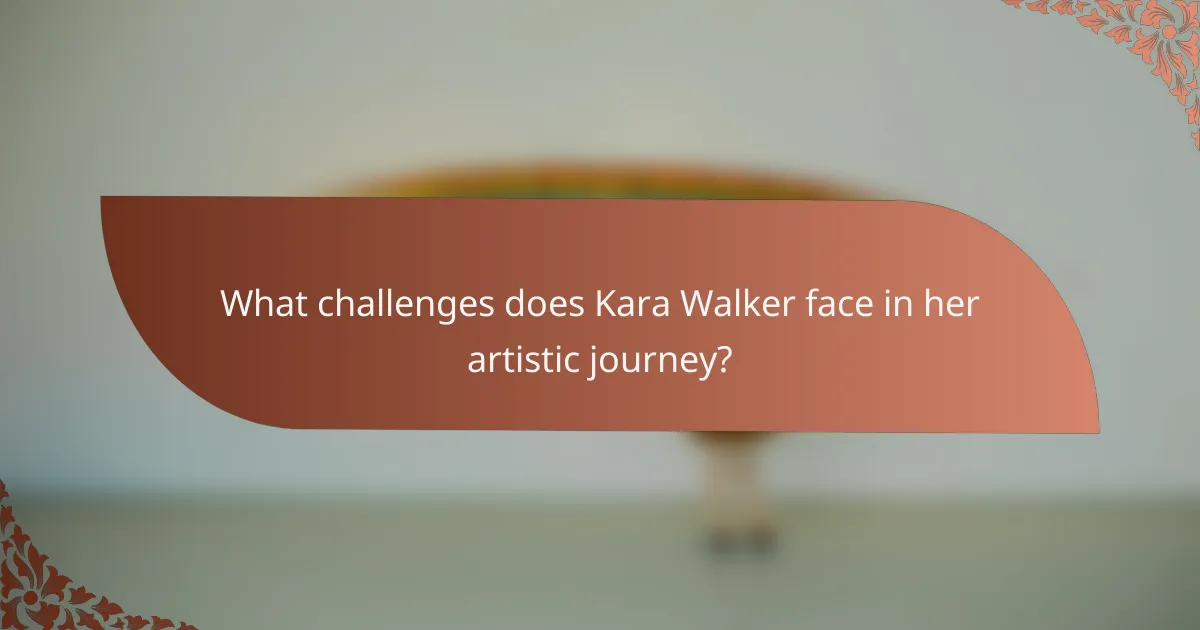
What challenges does Kara Walker face in her artistic journey?
Kara Walker faces challenges in addressing complex themes of race and identity while navigating public perception. Her work often elicits strong reactions, which can hinder open dialogue. Additionally, she confronts the pressure of representing Black experiences authentically. The art world’s expectations can limit her creative freedom, complicating her artistic journey.
How does she navigate criticism and controversy?
Kara Walker navigates criticism and controversy by embracing dialogue and challenging societal norms. Her provocative art often addresses complex themes of race and identity, prompting discussions that can be uncomfortable yet necessary. Walker’s unique attribute lies in her ability to use historical narratives and personal experiences to confront viewers, making them reflect on their perceptions. As a result, she transforms criticism into opportunities for deeper engagement with her work and its implications.
What are the financial and institutional barriers in the art world?
Financial and institutional barriers in the art world include limited access to funding, lack of representation, and systemic biases. These obstacles disproportionately affect artists of color, including those like Kara Walker, who challenge race and identity in their work.
Funding challenges arise from traditional art institutions that prioritize established artists, limiting opportunities for emerging voices. Representation issues persist, as galleries and museums often showcase a narrow range of artists, sidelining diverse perspectives.
Additionally, systemic biases within art institutions can hinder the recognition and support of artists who confront complex themes, such as race and identity. This creates an environment where innovative works struggle to gain visibility and financial backing.
Addressing these barriers requires a concerted effort to diversify funding sources, increase representation in exhibitions, and dismantle systemic biases within the art world.
What strategies can artists learn from Walker’s experiences?
Artists can learn several strategies from Kara Walker’s experiences. Firstly, they can embrace the power of narrative to explore complex themes like race and identity. Walker’s use of silhouettes tells stories that provoke thought and dialogue. Secondly, artists should consider the impact of historical context in their work. Walker often references historical events, which adds depth and relevance. Additionally, artists can adopt a bold approach to challenging societal norms. Walker’s fearless exploration of uncomfortable subjects encourages others to confront difficult topics. Lastly, collaboration with diverse communities can enrich artistic expression, as seen in Walker’s projects that engage various voices and perspectives.

How can educators incorporate Kara Walker’s themes into art curricula?
Educators can effectively incorporate Kara Walker’s themes into art curricula by emphasizing discussions on race and identity. They can utilize her works to inspire critical thinking about historical narratives and representation in art.
1. Analyze Walker’s artworks to explore themes of race, gender, and identity.
2. Facilitate classroom discussions that connect her themes to current social issues.
3. Encourage students to create their own art that reflects personal or societal identities.
4. Integrate interdisciplinary approaches, linking art with history and literature to deepen understanding.
5. Organize exhibitions or presentations that showcase student interpretations of Walker’s themes.
What are effective methods for discussing race and identity in classrooms?
Effective methods for discussing race and identity in classrooms include fostering open dialogue, utilizing diverse materials, and encouraging critical thinking. Creating a safe environment allows students to express their perspectives on race and identity. Incorporating modern art, such as Kara Walker’s work, can stimulate discussions about historical and contemporary issues related to race. Walker’s unique artistic style challenges societal norms and provokes thought, making it a valuable tool for educators. Engaging students with art can enhance their understanding of complex identity issues and promote empathy.
How can Walker’s work inspire critical thinking among students?
Kara Walker’s work can inspire critical thinking among students by challenging perceptions of race and identity. Her provocative art encourages dialogue about historical narratives and societal issues. By analyzing her pieces, students can explore complex themes such as power dynamics and cultural representation. This engagement fosters analytical skills and promotes deeper understanding of contemporary social issues. Walker’s unique approach to storytelling through visual art serves as a catalyst for critical discussions in educational settings.
What are common pitfalls to avoid when teaching her art?
Common pitfalls to avoid when teaching Kara Walker’s art include oversimplifying themes, neglecting historical context, and failing to encourage critical discussion.
One major issue is oversimplifying the complex themes of race and identity present in her work. This can lead to misunderstandings of her artistic intent. Additionally, neglecting the historical context of racial narratives can diminish the impact of her art. Finally, failing to foster critical discussions may prevent students from fully engaging with the deeper meanings behind her pieces.
What best practices can enhance the understanding of her contributions?
Kara Walker’s contributions can be enhanced through contextual education, critical engagement, and diverse perspectives. Contextual education involves exploring her historical background and the socio-political themes in her work. Critical engagement encourages discussions that challenge viewers to reflect on race and identity. Diverse perspectives include incorporating insights from various cultural backgrounds to enrich the understanding of her art. Each approach deepens appreciation and fosters a more nuanced interpretation of her contributions.
